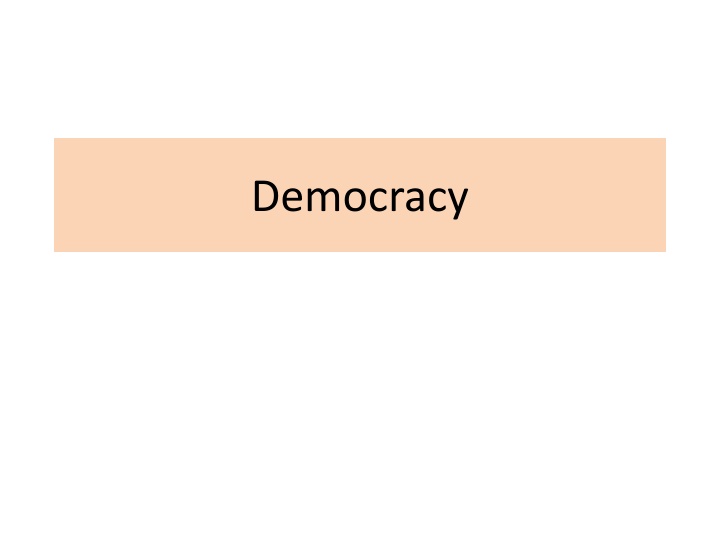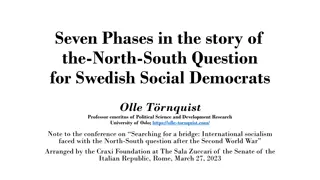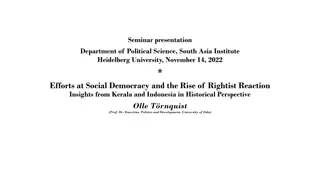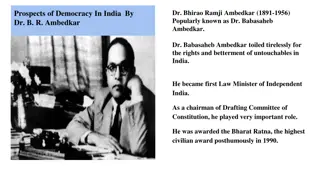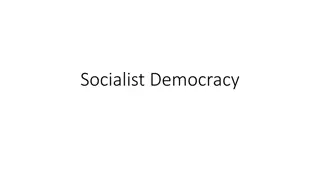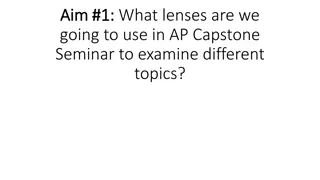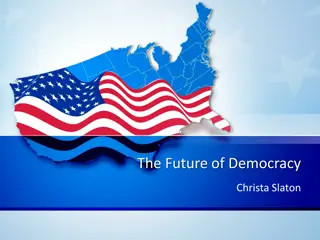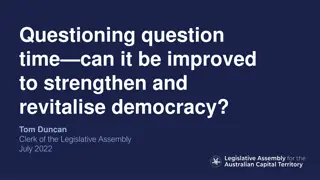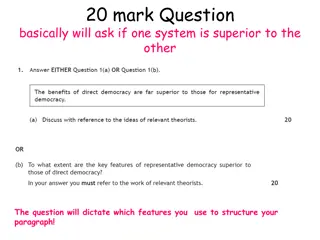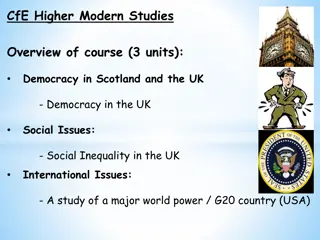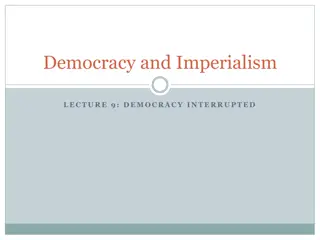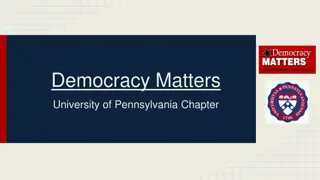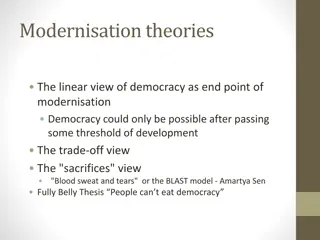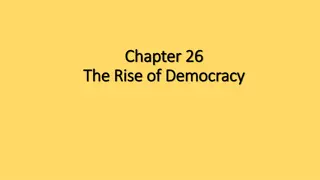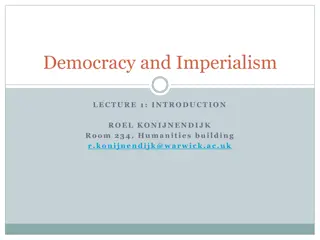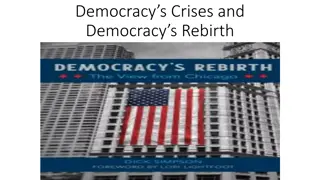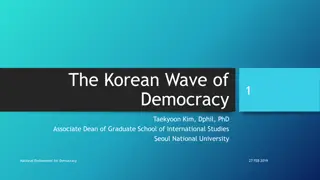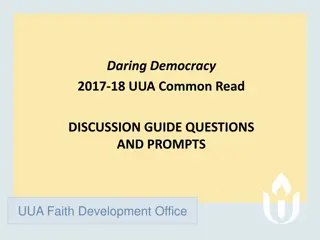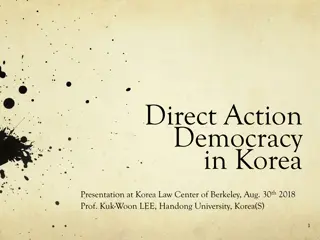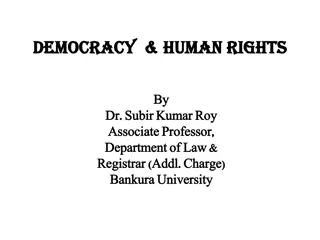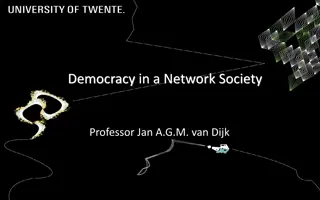Democracy
The relation between jumps and six explanatory variables is analyzed in the main case with N=649. The relationship between jumps and T is almost linear, while the relation with y shows no clear pattern. Additionally, jumps and g exhibit the same-year growth with a +10% censoring, and jumps and g5 represent the growth over the preceding five years, also censored to +10%. More insights are provided on the weak bends at the top for jumps and P-1, as well as the presence of bad bends at the top and bottom for jumps and P.
Download Presentation

Please find below an Image/Link to download the presentation.
The content on the website is provided AS IS for your information and personal use only. It may not be sold, licensed, or shared on other websites without obtaining consent from the author.If you encounter any issues during the download, it is possible that the publisher has removed the file from their server.
You are allowed to download the files provided on this website for personal or commercial use, subject to the condition that they are used lawfully. All files are the property of their respective owners.
The content on the website is provided AS IS for your information and personal use only. It may not be sold, licensed, or shared on other websites without obtaining consent from the author.
E N D
Presentation Transcript
The term democracy comes from the Greek language and means "rule by the (simple) people". Like modern democracy, they were created as a reaction to a concentration and abuse of power by the rulers. Yet the theory of modern democracy was not formulated until the Age of Enlightment (17th/18th philosophers defined the essential elements of democracy: separation of powers, basic civil rights/human rights, religious liberty and separation of church and state. centuries), when
Since 1900, the number of independent states has grown from 55 to nearly 200. Today, governments in 120 countries are formed by democratic method. About 62.5% of the world s population live in those countries. Key events which led to this expansion: The defeat of fascism in World War 2 (1939-45) The fall of Western colonial empires (1950s-70s) The fall of Western authoritarian regimes in Southern Europe and Latin America (1970s-1980s) The fall of Communist regimes in Eastern Europe and the Soviet Union (1989-91)
Different Paths to Democracy We democratic regimes (US, Western Europe) Some states reject the Western democratic model (e.g. Russia) Some outer-European states aspirate for Western-style democracy, but have a weak socioeconomic base and alternative traditions that may compete with democracy (Latin America) Also, there are successful economic modernizers being not within Western cultural traditions and political systems. They are experimenting with their own hybrid forms of democracy (East Asia) Another group are non-Western countries that have neither the socioeconomic base for democracy nor a clear and strong democratic historical and cultural tradition (e.g. Islamic countries and sub-Saharan Africa). can identify variations among well-established,
The Classical Theory of Democracy U.S. president Abraham Lincoln (1809-1865) defined democracy as: Government of the people, by the people, for the people The triple meaning: 1. Democracy as source of state authority power of the people 2. Democracy as the purpose of government the common good 3. Democracy as a method of choosing political leaders by the people
Joseph Schumpeter (1942): The classical theory is too broad and vague. It is much more practical to narrow the meaning of democracy to the method: The democratic method is that institutional arrangement for arriving at political decisions in which individuals acquire the power to decide by means of a competitive struggle for the people s vote .* *Joseph Schumpeter, Capitalism, Socialism, and Democracy. New York: Harper, 1947, p.269
Two major dimensions of the democratic method:* contestation free and fair competition between candidates participation all adult citizens have the right to vote The use of this method requires the freedoms of: expression (to speak publicly and publish one s views), assembly (to gather for political purposes), association (to form political organizations) *Robert A. Dahl, Polyarchy: Participation and Opposition. New Haven: Yale University Press, 1971; Samuel Huntington, The Third Wave. Democratization in the Late Twentieth Century. University of Oklahoma Press, 1991
In contemporary politics, the term democracy is used mostly in the Schumpeterian, rather than classical sense: Representative democracy Electoral democracy Formal democracy The people elect a government and keep it accountable
Different types of conception of democracy Procedural Conceptions Substantive Conceptions Minimal conceptions Middle-ground Conceptions Maximal conceptions
Three Ways of Conceptualizing Democracy 1. A procedural or minimal conception. Among the first group of scholars (such as Joseph Schumpeter, Robert A. Dahl, Seymour Martin Lipset), the Schumpeterian definition is a minimal conception of democracy, which emphasizes the single most important defining property of democracy the authority of government derives from the consent of people or electoral participation through free, open and contested elections.
2. A substantive or maximal conception. Some other scholars tend to stress conceptual breadth, which involves a larger number of defining properties intrinsic to democracy. Under this definition, the conception of democracy embraces effective and responsible government, informed and rational deliberation, honest and openness in politics, economic equality, equal participation and power, social justice, and various other civic virtues.
3. A middle-ground position. Still others, such as Terry Lynn Karl, choose a middle ground for defining democracy in order to avoid either an overly narrow or overly broad definition, with the concept being defined with reference to a small number of characteristics that distinguish it from other political systems. 1. allow the contestation over power in free and fair elections 2. accountability of the ruler to the ruled 3. checks and balances in the exercise of government 4. the neutrality of the armed forces 5. protection of civil and political liberty and rights of every citizen.
MODELS OF DEMOCRACY Individual Rights/ Limited Gov t Liberal Democracy High Mass Participation Low Mass Participation Elite Democracy Majoritarian Democracy General Welfare
Models of Democracy Majoritarian democracy most important goal is maximizing mass participation high mass participation will result in decisions being made that maximize the general welfare
Elite democracy most important goal is the general welfare requires an elite capable of pursuing the long-term interests of society actually values low mass participation
Liberal democracy most important goal is protecting individual rights does not prefer low mass participation but may be willing to accept it
Models of Democracy: Critiques Majoritarian democratic critiques of other models Elite democracy there is no such thing as an elite that is not self-interested and will look after the good of the general masses Liberal democracy emphasis on individual rights is used to limit government in order to protect small, priveleged groups
Elite democratic critiques of other models Liberal democracy undue focus on individual rights limits government s ability to pursue the general welfare of the community Majoritarian democracy masses are too uninterested, incompetent or, at worst, dangerous to be given control over decision-making
Liberal democratic critiques of other models Elite democracy if unchecked, elites will use power to infringe the rights of individuals Majoritarian democracy if unchecked, majority will infringe the rights of minorities (tyranny of the majority)
Models of Democracy Viewing Democracy Over Time Elite democrats the masses will always be incapable of making decisions for the long-term common good Liberal democrats elites and the majorities will always be prone to infringing individual rights if given the chance Majoritarian democrats elites will always be self-serving masses can learn over time to become better democratic citizens if given a meaningful opportunity to do so
As a model, it sounds attractive, but what happens in real life? If society is large, complex, divided, can it get organized to control the state especially a large and powerful state? Perhaps, only to a limited degree
Things to Remember... There is no one or single accepted model of democracy Within a range of basic elements (consent of the governed, protection of individual rights), democracy means different things to different people Democracy is a contested concept People s power ? But can the people rule? democracy versus oligarchy
The iron law of oligarchy is a political theory, first developed by the German sociologist Robert Michels in his 1911 book, Political Parties. It states that all forms of organization, regardless of how democratic or autocratic they may be at the start, will eventually and inevitably develop into oligarchies. The reasons behind the oligarchization process are: the indispensability of leadership; the tendency of all groups, including the organization leadership, to defend their interests; and the passivity of the led individuals.
He found that, paradoxically, the socialist parties of Europe, despite their democratic ideology and provisions for mass participation, seemed to be dominated by their leaders, just like traditional conservative parties. democratic modern era allowed the formation of organizations with innovative and revolutionary goals, but as such organizations become more complex, they became less and less democratic and revolutionary. Michels formulated the "Iron Law of Oligarchy": "Who says organization, says oligarchy." The more liberal and
Democratization Democratic transition refers to a political process of movement aimed at establishing a democratic political system, initiated either from above or below or a combination of both, allowing bargaining and compromise among different political forces for the resolution of social conflicts, institutionalizing the pluralist structures and procedures by which different political forces are allowed to compete over the power, regularizing transfer of power, and engaging in the fundamental transformation of political structure.
Democratic Consolidation is a discernible process by which the democratic norms, rules, and institutions constitute the only game in town, the only legitimate framework for seeking and exercising political power, and through which democracy standardized and deeply internalized in institutional, social, and cultural life. In consolidated democracy, there may be intense conflicts, but no significant political actors attempt to achieve their objectives by illegal, unconstitutional, or antidemocratic means. becomes
Hadenius & Berg-Schlosser (2004: 98) apply four basic criteria of democratic consolidation : An unbroken series of free and fair elections Institutionalized changes of government The absence of significant anti-democratic forces Mass support for democratic principles
Democracy and the Rule of Law Why is the rule of law a pre-requisite for democratic consolidation and democracy? Rule of law obliges the state to follow objective rights. As Guillermo O Donnell explains, under a rule of law all citizens are equal before the law, which is fairly and consistently applied to all by an independent judiciary, and the laws themselves are clear, publicly known, universal, stable, and non-retroactive. What makes a rule of law democratic is that the legal system defends the political rights and procedures of democracy, upholds everyone s civil rights, and reinforces the authority of other agencies of horizontal accountability that ensure the legality and propriety of official actions.
Rule of Law: Pre-requisites The most important conditions aiding the development of law-based rule are: the diffusion of liberal and democratic values at both popular and elite levels strong bureaucratic traditions of competence and impartiality, and adequate institutional and economic means
Components of Rule of Law All actions of the state are determined by law All citizens are to be treated equally/The law is no respecter of persons Independent courts secure civil and human rights
